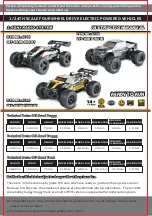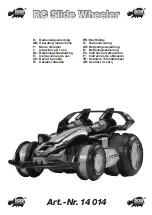
55
© REELY 01/08
6
S
ET
-U
P
The alignment designates the position of the wheel level to the driving direction.
During the drive the tires are pushed apart in the front because of the rolling friction and this is why they are no longer
exactly parallel to the drive direction. To balance, the wheels of the stationary vehicle can be set, so that they point slightly inward.
This
toe-in
effects an improved lateral cornering of the tire and therefore a more direct response of the steering If a milder response of steering is
desired, this can be achieved accordingly by adjusting a
toe-out
, i.e. the wheels of the stationary vehicle point outward.
For a
rough
adjustment
of the alignment, the outer steering links can be screwed on the middle steering link part at two further fastening points.
The clamping screws with spanner flat
(5mm) for the separate adjustment of the inclination of the front wheel are located in the right and left stee-
ring link.
The toe-in of the front wheel must not exceed 4°.
S
ETTING
THE
ALIGNMENT
6.4
Fine tuning of inclination on front and rear wheels
-
Twist clamping screw in the upper transverse link
clockwise:
The upper edge of the wheel is pulled inward in direction
“negative inclination”.
-
Twist clamping screw in the upper transverse link
anticlockwise:
The upper edge of the wheel is pulled outward in direction
“positive inclination”.
Ensure a balanced tuning of the cornering power of front and rear
axles as differences can result in an
over-steering or an under-steering driving behavior.
�����������
Toe-in
Setting a toe-in makes the
inner part of the tires wear faster.
������������
Toe-out
Setting a toe-out makes the
outer part of the tires wear faster.
(a)
Содержание 23 49 70
Страница 2: ...UPGRADE 11 08 ...
Страница 3: ......
Страница 132: ...129 No 23 49 70 REELY 01 08 ...
Страница 133: ...130 No 23 49 70 REELY 01 08 ...
Страница 134: ...131 No 23 49 70 REELY 01 08 ...
















































